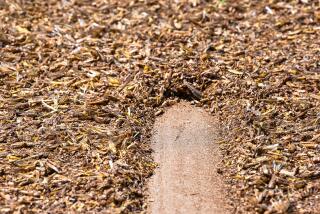Grasshoppers Peril Crops in 6 Western States
- Share via
BUHL, Ida. — Pausing in his desperate race against disaster, Tom Davis, a farmer, fingered a tender young plant neatly chewed through by the grasshoppers jumping in the barley around him.
“They like to eat green,” he said of the grasshopper infestation, which federal officials call the nation’s worst in 50 years. “It’s frustrating. One day you get a good kill from spraying (pesticide), and you go back in two days and everything is infested again.
“Now I know how Don Quixote felt.”
‘Very Serious Threat’
Here in the Magic Valley of Idaho, as in many places across the West this year, a massive infestation of grasshoppers has descended on millions of acres of crops and rangeland in what federal officials call a “very serious threat to Western agriculture.”
To cope with it the U.S. Agriculture Department has begun a $25- million pesticide-spraying effort on up to 9.7 million acres of Western rangeland. Already, more than 4 million acres in the region have been sprayed with grasshopper-killing malathion--2.5 million acres in Idaho alone.
The insects are devouring corn, barley, sugar beets, dry edible beans, potatoes, alfalfa and grazing forage.
“They’re just eating us up,” said William F. Hazen, the agricultural extension agent for Twin Falls County. “It’s extremely serious.” Government and farmers have been forced to undertake expensive pest-control spraying that may well be too late. Officials also are investigating reports that some farmers have started setting range fires as a means of fighting the infestation.
“The economic impact we haven’t seen yet,” Hazen said. “We’ve got farmers stretched out to the living end (by a depressed agricultural economy). This will be a general hardship on many, many people.
“And for selected individuals it will be disaster. This has the potential to break them.”
Spraying by Hand
“I don’t know what it’s going to do,” Davis said of the grasshoppers’ ultimate impact on his 3,000-acre operation. “Anytime you have something like this, it costs you in production and it costs you in control. We’re spending $250 to $300 a day spraying by hand.”
“What is going to happen, I don’t know,” said Roger J. Pollard, the Idaho officer in charge at the Agriculture Department’s Animal and Plant Health Inspection Service in nearby Twin Falls. “I’d like to be further along with spraying.”
Nearly 50 additional federal workers have been brought to Idaho to fight the grasshoppers, and 38 aircraft, including three Air Force C-123s, have been mobilized for spraying in the state.
Others States Affected
But Idaho is not the only state affected. Arizona, Colorado, Oregon, Utah and Wyoming are all experiencing grasshopper infestations of varying degrees.
The grasshoppers are the unwanted offspring of a widespread infestation last year that left unusually large numbers of eggs to hatch this season. This year’s hot, dry spring allowed massive numbers of newly hatched grasshoppers to survive in almost plague proportions.
But government land programs and federal spending cutbacks, which all but eliminated pest-control programs, have also contributed to the problem, officials here said.
Pollard said the U.S. Bureau of Land Management’s “desert entry program” has enticed farmers to spread into prime grasshopper territory without requiring buffer zones between their vulnerable cropland and the surrounding untilled federally owned rangeland. There, many grasshoppers hatch and feed before moving into private cropland.
‘Hometown’ for Grasshoppers
“This is ‘Hometown, U.S.A.’ for grasshoppers,” Pollard said of the northern high desert here. “People have taken their agriculture into the beast’s homeland and BLM lets them farm right up to the fence. BLM has basically said, ‘Someone will protect you.’ ”
But, he added, “most of Idaho is government land and the federal government does have some responsibility to take care of it. The farmers feeling the severe damage are the ones immediately adjacent to federal land.”
Davis, 49, has seen the hungry grasshoppers invade his crops from adjoining federal land. They have penetrated his barley, beets and beans, and his only hope is that his crop of late sweet corn can develop enough before the grasshoppers reach it, too.
Munching His Barley
However, the grasshoppers are methodically munching their way through barley that stops just 10 yards from the sweet corn, so his is a race against time.
“The corn is going to have a real vulnerable stage coming up when the silk bud starts forming,” Davis said. “That’s payday. That’s when you got corn, or that’s when you got fodder.
“We’ve almost resolved to give them 200 acres of barley to save the rest,” Davis said during a tour of his farm, where grasshoppers killed during a recent hand-spraying of pesticide are being replaced by still more grasshoppers.
“It looks to me like we’re going to have to spray the whole farm by airplane--$12,000 to $15,000. It’s going to be a great financial burden. We don’t have anything in our budget (for grasshopper control) and we’ve spent $10,000 to $15,000 already and we haven’t scratched the surface.”
His land was broken out of desert and irrigated shortly before he started farming here 15 years ago. Of the poor farm economy, he said, “We’ve been about paying our bills. We had no room for any new machinery this year at all. You hate to give up, but it reaches the point where you can’t keep throwing good money after bad.
“But how could you stand here and just watch them take your crop? You can’t do that.”
More to Read
Sign up for Essential California
The most important California stories and recommendations in your inbox every morning.
You may occasionally receive promotional content from the Los Angeles Times.













